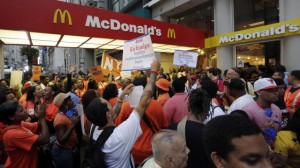
Protesting fast food workers demonstrate outside a McDonald's restaurant on New York's Fifth Avenue, Thursday, Aug. 29, 2013. (AP Photo/Richard Drew)
After decades of seeing their incomes shrink, those at the bottom of the economic ladder are starting to band together and fight back — and it’s one of the most important economic stories of our time.
Between 1973 and 2011, the top 10 percent of American households saw their inflation-adjusted incomes rise by almost $100,000, while the bottom 90 percent – the vast majority of us –actually saw their incomes drop by $4,425 per year, according to economists Emmanuel Saez and Thomas Piketty (XLS). During that time, pensions largely disappeared, and the costs of health care and education shot through the roof.
Today, we’re seeing those at the bottom of the economic pile — the 35 million Americans who make $10.55 per hour or less, representing more than a quarter of our workforce — starting to band together and fight back.
Low-wage workers are demanding a living wage (defined as the minimum required to cover basic necessities) and the ability to bargain collectively. Brief strikes by fast-food workers seeking $15 an hour, a campaign that’s brought together traditional labor unions with local community groups, are spreading across the country – last week, walk-outs reportedly occurred in 60 cities.
“The way that this movement has intertwined itself with community organizing has really helped it spread like wildfire,” says Greg Basta, deputy director of New York Communities for Change. “People are realizing that these low-wage jobs, at companies like McDonald’s, are doing serious damage to their community and to their local economy,” he said.
This week, Wal-mart workers and their supporters with the group Our Wal-mart are planning walk-outs in 15 cities, to protest the retail giant’s retaliation against workers who participated in last November’s Black Friday strikes.
But it’s not just companies like Wal-mart and McDonald’s paying their employees too little. According to a study by Demos, the federal government, indirectly, is the nation’s largest low-wage employer. A coalition called Good Jobs Nation began a campaign earlier this year urging President Obama to sign an executive order requiring federal contractors to pay their employees a living wage. With the stroke of a pen, Obama could lift the living standards of two million American workers.
These campaigns are filling a gap left by Congress, which hasn’t raised the federal minimum wage fast enough to keep up with the cost of living. Poverty wages represent a type of “market failure.” Like selling widgets for less than what it costs to make them, low-wage workers are selling their labor for less than what it costs to cover the basic necessities of life, which is why taxpayers end up subsidizing the profits of low-wage employers with various public benefits. “In today’s economy, the math simply doesn’t make sense,” says Basta. “If you’re paying workers between $10,000 and $18,000 a year, it’s impossible to live in a place like New York City without receiving public assistance.”
Greg Basta explains that before the fast-food workers campaign got underway, “people who were working low-wage jobs didn’t even think about the possibility of organizing or fighting for higher wages. They bought into the mentality that they’re not worthy of fighting back. They bought into the mainstream mentality that their jobs just aren’t ‘good jobs.’ And to see the evolution of these workers from being really fearful to now saying, ‘we’re fighting because this is the right thing to do’ – that transformation I’ve seen on the ground in the past year and a half is the most moving thing I’ve ever been a part of.”
There’s no particular reason why millions of service workers should be paid poverty wages. With the exception of occupations that require rare skills or lots of education, there’s often a loose correlation between what people are paid and how much value they offer to society.
For instance, manufacturing jobs pay decent wages, but not because operating machines in a factory requires some special magic. Over 10 percent of manufacturing workers were covered by a union contract last year, compared with around seven percent of private sector workers overall. And fewer than five percent of food preparation and serving related professions belonged to a union in 2012, according to the Bureau of Labor Statistics.
Throughout American labor history, people working what society viewed as inherently crappy jobs fought hard to make them decent jobs with a modicum of human dignity.
In the last century, the meatpacking industry provides a good case study. In 1906, Upton Sinclair’s The Jungle shocked the public when it exposed meatpacking as a dangerous, disgusting occupation that paid slave wages. Workers organized throughout the 1920s and 1930s – often facing violent retaliation – and in 1943, they formed the United Packinghouse Workers of America (UPWA), based in Chicago, where the country’s biggest livestock yards were located.
The occupation got safer. And for a few decades mid-century, it paid more or less the same as a good manufacturing job. But in the 1970s and 1980s, as corporate union-busting accelerated dramatically, meat processors moved their operations closer to cattle and swine lots as the industry shifted transport from rail to truck. Far from its original urban base, and with new high-speed cutting machines making the industry less labor-intensive, the UPWA had a harder time organizing, and the union was gradually decimated. Today meat processing is once again an industry that relies heavily on low-wage, migrant labor. According to a 2005 report by Human Rights Watch, it’s also the most dangerous manufacturing job in America.
Now, another group of low-wage workers who often toil in uncomfortable, under-regulated workplaces are fighting for some basic human dignity. Whether they succeed or fail is just as important for the middle class as it is for the working poor. Not only do rising wages at the bottom exert upward pressure on the earnings of people higher up on the ladder, but poverty and inequality also give rise to a host of social disorders that affect us all. Cheap fast-food ultimately comes with high hidden costs.


